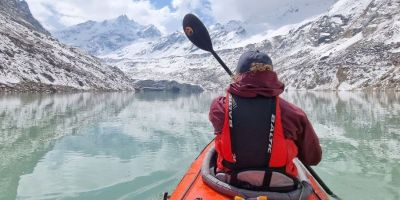Meltwater lakes are accelerating glacier ice loss

Meltwater lakes that form at glacier margins cause ice to recede much further and faster compared to glaciers that terminate on land, according to a new study.
But the effects of these glacial lakes are not represented in current ice loss models, warn the study authors.
Therefore, estimates of recession rates and ice mass loss from lake-terminating glaciers in the coming decades are likely to be under-estimated.
Many mountain glaciers now terminate in such lakes, formed as meltwater becomes trapped behind ridges of glacier debris. They are known as proglacial lakes. Climate change has increased glacier melt worldwide and this in turn has led to a dramatic increase in the size and number of proglacial lakes.
But the effects of proglacial lakes on the rates of deglaciation and on glacier behaviour have been poorly understood.
Now, an international team of researchers, led by the University of Leeds, has quantified for the first time the influence of proglacial lakes on mountain glaciers using computer simulations.
They found that the presence of a proglacial lake causes a glacier to recede more than four times further and accelerate ice flow by up to eight times when compared to the same glacier terminating on land under the same climate.
An ice cube in a bowl of water is going to melt much more quickly than an ice cube sitting on a table, and the effect proglacial lakes have on glacier ice is roughly the same.
The findings, published today in the journal Geophysical Research Letters, show that a land-terminating glacier took 1000 years to succumb to the same amount of recession as a lake-terminating glacier experienced in 100 years.
Study lead author Dr Jenna Sutherland undertook this research while a PhD candidate in the School of Geography at Leeds. She said: “An ice cube in a bowl of water is going to melt much more quickly than an ice cube sitting on a table, and the effect proglacial lakes have on glacier ice is roughly the same.
“The simulations show that the influence of a proglacial lake on a glacier predominantly takes place over decades to centuries rather than over millennia, meaning the glacier recedes much faster than it ever could from climatic changes alone.”
Study co-author Dr Jonathan Carrivick, a senior lecturer in geomorphology at Leeds, said: “Our findings suggest that simulations of past, contemporary or future glaciers ignore the effects of ice-contact lakes and will likely mis-represent the timing and rate of recession, especially the changes to the timing and rate that will occur once a proglacial lake forms.
“This effects need to be included in all future models and simulations if we are to have an accurate global picture of glacial ice loss.”
The team used the BISICLES ice-flow model, to analyse the effects of a proglacial lake on the Pukaki Glacier, New Zealand, during recession from the end of the last ice age.
Study co-author James Shulmeister, from the University of Canterbury, New Zealand, said: “While this study focussed on New Zealand, proglacial lakes are prevalent during glacial retreat worldwide and this paper should therefore be of global interest and importance.”
In addition, he noted: “This study is also critical because the timing of ice retreat is often used to determine the synchrony or lack thereof in climate events globally.
"Major inferences have been made about the roles of phenomena like oceanic circulation in affecting the global climate system from glacial retreat timings. If the timings are wrong, the relationship between these processes may need to be re-examined.”
Further information
Top image: Hooker Lake, New Zealand (2016) credit: Jenna Sutherland
The paper Proglacial lakes control glacier geometry and behavior during recession is published in Geophysical Research Letters on 08 October 2020





